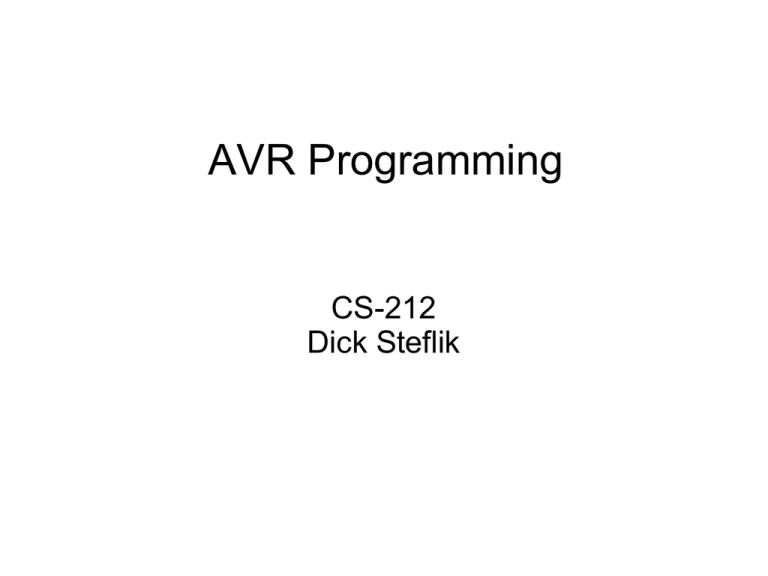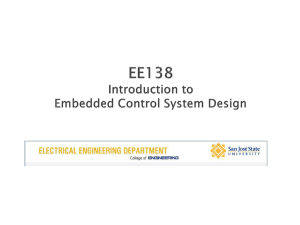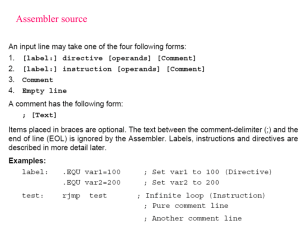AVR Programming - Computer Science
advertisement

AVR Programming
CS-212
Dick Steflik
ATmega328P
I/O for our labs
To get data into and out of our Arduino its a little
trickier than using printf and scanf as you did in
CS211
Since the Arduino doesn't have an Operating
System we need to write and read data directly
to/from the I/O ports
Access to the ports is through the Special
Function Registers (SFRs) that are defined
symbolically in iom328p.h which is included in
your program by io.h
io.h
# include <avr/iom165p.h>
#elif defined (__AVR_ATmega168__)
# include <avr/iom168.h>
#elif defined (__AVR_ATmega168P__)
# include <avr/iom168p.h>
#elif defined (__AVR_ATmega169__)
# include <avr/iom169.h>
#elif defined (__AVR_ATmega169P__)
# include <avr/iom169p.h>
#elif defined (__AVR_ATmega8HVA__)
# include <avr/iom8hva.h>
#elif defined (__AVR_ATmega16HVA__)
.
.
.
# include <avr/iom3250.h>
#elif defined (__AVR_ATmega3250P__)
# include <avr/iom3250.h>
#elif defined (__AVR_ATmega328P__) || defined (__AVR_ATmega328__)
# include <avr/iom328p.h>
#elif defined (__AVR_ATmega329__)
# include <avr/iom329.h>
#
iom328p.h
/* avr/iom328p.h - definitions for ATmega328P. */
/* This file should only be included from <avr/io.h>, never directly. */
#ifndef _AVR_IO_H_
# error "Include <avr/io.h> instead of this file."
#endif
#ifndef _AVR_IOXXX_H_
# define _AVR_IOXXX_H_ "iom328p.h"
#else
# error "Attempt to include more than one <avr/ioXXX.h> file."
#endif
#ifndef _AVR_IOM328P_H_
#define _AVR_IOM328P_H_ 1
/* Registers and associated bit numbers */
#define PINB _SFR_IO8(0x03)
#define PINB0 0
#define PINB1 1
#define PINB2 2
#define PINB3 3
#define PINB4 4
#define PINB5 5
#define PINB6 6
#define PINB7 7
#define DDRB _SFR_IO8(0x04)
#define DDB0 0
#define DDB1 1
#define DDB2 2
#define DDB3 3
#define DDB4 4
sfr_defs.h
included in every compile via io.h
contains macro definitions for accessing Special
Function Registers as if they were just c
language variables
in iom328p.h the statement:
#define PINB _SFR_IO8(0x03)
the symbol PINA is mapped to the SFR at
address 0x03 in SFR memory
_SFR_IO8( ) is a macro (look in sfr_defs.h )
Why this is done
in your program you #include io.h and io.h in
turn includes iom328p.h (because in your
project definition you picked the ATmega328p
as the processor)
pass 1 of the compiler does all includes and
macro substitutions ( in our example with PINA
all occurrences of the symbol PINB in your
program will be replaced with a reference to
SFR 0x03)
This makes all SFR references look like
references to C variables
Memories
Getting Digital Data Into and Out Of
Initialize the ports B or D
set bits in the Data Direction Registers (DDRB and
DDRD) for input or output
use PORTB or PORTD for output
1 for output ; 0 for input
don't forget the current limiting, series resistors
use PINB or PIND for input
don't forget the pull-up resistors
Blink.c
/*------------------------------------------------------------------------------*/
/* Name: Blink.c
*/
/* Author: Steflik
*/
/* Description: This is the MCU equivalent of Hello World, instead of saying
*/
/* “Hello World” it blinks an led at a one second rate
*/
/*------------------------------------------------------------------------------*/
#include <avr/io.h>
#define F_CPU 16000000UL
#include <util/delay.h>
//This contains definitions for all the registers locations
//
other things, must always be included
//F_CPU tells the compiler that our crystal is an 16Mhz one
//
can generate an accurate delay, must be declared above
//
delay knows what is the value of F_CPU
//Contains some delay functions that will generate accurate
//
of ms and us
and some
so it
delay so
delays
int main(void){
//In ANSI C, the main function as always an int return and using
//
void will give you an warning
DDRB |= (1<<PB5);
//Define digital pin13/PORTB5 as an output so we can blink our led
while(1){
//This gives us an infinite loop, there should always be an infinite loop
// in your code, because micro-controllers cant return from main
// to anywhere and that will give you bad results and unpredicted
// behavior
PORTB |= (1<<PB5);
_delay_ms(1000);
PORTB &= ~(1<<PB5);
_delay_ms(1000);
}
return 1;
}
//Turn
//Wait
//Turn
//Wait
led on, this is the led included in the arduino(digital pin 13)
1 second
led off
another second
daemons
a daemon is a program that will sit in memory
forever and run until the system loses power
since most embedded system run forever (until
they lose power) our main() should be written
as a never ending loop.
processing to be done can be done either in the
body of the loop or asynchronously in response
to an external or internal event (interrupt)
Interrupts
How Interrupts are handled
Somewhere in your program you define an
Interrupt Servicing Subroutine (ISS), the
compiler will put the address of this routine into
the proper location in the interrupt vector (low
memory)
When the interrupt occurs the system state is
saved, a branch to the ISS is made via the
interrupt vector
The ISS executes and returns the state of the
system and you are right where you were
before the interrupt occurred
ATmega328p Interrupt Vector
What we want to do
use 8 LEDs for output
8 switches for input
1 button to tell when it is OK to read the
switches
to do this we should us an interrupt
The way it should work
/* Interrupt handler */
{
// disable interruptes
// read the switches
// save the data at the next location in an array
// light the lights
// enable interrupts
}
int main ()
{
// initialize ports B & D
// initial Port E for interrupt on PE2
// loop forever – this is our daemon
}
volatile keyword
the keyword “volatile” should be used to define
any variable that may be modified inside of an
interrupt handler
“volatile” flags a variable to the optimizing
compiler to not optimize variables with the
“volatile” keyword
volatile char
switches = 0;
volatile uint8_t flags = 0;
char & uint8_t
Remember the char data type can be used for
ASCII characters or a signed 8 bit integer
The AVR header files define another data type
that allows an unsigned 8 bit integer, this is
convenient for working with gpio ports as they
are not usually signed data.
internal pullups for gpio inputs
on many MCUs you must add an external
pullup resistor on gpio input lines
Atmel MCUs have built-in internal pullup
resistors
to use the internal pullups write a one to that line
after it has been defined as an input line in the DDR
// define Port B as all outputs and Port D as all inputs
DDRB = 0xFF;
DDRD = 0x00;
//turn on the internal pullup resistors for Port D
PORTD = 0xFF;
Setting up an interrupt handler
Signal or ISR
the ISR macro has superceded the Signal macro
and is the preferred way of setting up an interrupt
handler
ISR( name of the int from processor .h file)
{
........
}
ISR(SIG_PIN_CHANGE1)
{
....
}
Pin Change Interrupts
Input lines on Ports B, C and D can be set up to
generate a pin change interrupt
Each port has an associated mask register
to enable an interrupt put a 1 into the correct
position in the appropriate mask register
Port B PCMSK2
Port C PCMSK1
Port D PCMSK0
PCINT Mapping
PCINT7
PCINT6
PCINT5
PCINT4
PCINT3
PCINT2
PCINT1
PCINT0
PORT D
7
6
5
4
3
2
1
0
PCINT23
PCINT22
PCINT21
PCINT20
PCINT19
PCINT18
PCINT17
PCINT16
PORT B
7
6
5
4
3
2
1
0
SIG_PIN_CHANGE0
SIG_PIN_CHANGE1
Example
//set bit 2 of Port B to cause an interrupt
PCMSK1 = 0x04;
// set bit 2 of Port B to cause interrupt
EIMSK = 0xC0;
// Ext Int Mask Reg
EIFR = 0xC0;
// Ext Int Flag Reg
DDRB & = 0xFB;
// make bit 2 an input line
PORTB | = 0x04;
// turn on pullup
ISR(SIG_PIN_CHANGE1)
{
cli( ); // disable interrupts
.
.
.
sei( ); // enable interrupts
}









